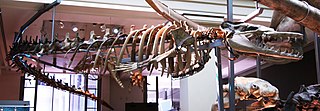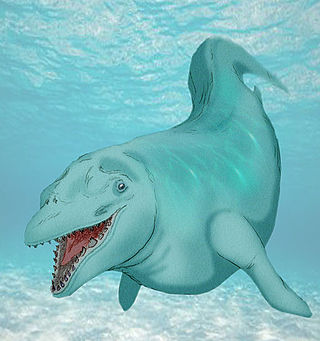
Podocnemididae is a family of pleurodire (side-necked) turtles, once widely distributed. Most of its 41 genera and 57 species are now extinct. Seven of its eight surviving species are native to South America: the genus Peltocephalus, with two species, only one of which is extant ; and the genus Podocnemis, with six living species of South American side-necked river turtles and four extinct. There is also one genus native to Madagascar: Erymnochelys, the Madagascan big-headed turtle, whose single species E. madagascariensis.

Basilosaurus is a genus of large, predatory, prehistoric archaeocete whale from the late Eocene, approximately 41.3 to 33.9 million years ago (mya). First described in 1834, it was the first archaeocete and prehistoric whale known to science. Fossils attributed to the type species B. cetoides were discovered in the United States. They were originally thought to be of a giant reptile, hence the suffix "-saurus", Ancient Greek for "lizard". The animal was later found to be an early marine mammal, which prompted attempts at renaming the creature, which failed as the rules of zoological nomenclature dictate using the original name given. Fossils were later found of the second species, B. isis, in 1904 in Egypt, Western Sahara, Morocco, Jordan, Tunisia, and Pakistan. Fossils have also been unearthed in the southeastern United States and Peru.

Wadi El-Ḥitan is a paleontological site in the Faiyum Governorate of Egypt, some 151 kilometres (94 mi) south-west of Cairo. It was designated a UNESCO World Heritage Site in July 2005 for its hundreds of fossils of some of the earliest forms of whale, the archaeoceti. The site reveals evidence for the explanation of one of the greatest mysteries of the evolution of whales: the emergence of the whale as an ocean-going mammal from a previous life as a land-based animal.
Protosiren is an extinct early genus of the order Sirenia. Protosiren existed throughout the Lutetian to Priabonian stages of the Middle Eocene. Fossils have been found in the far-flung locations like the United States, Africa (Egypt), Europe and Asia.
Karanisia is an extinct genus of strepsirrhine primate from middle Eocene deposits in Egypt.
Paratomistoma is an extinct monospecific genus of gavialoid crocodylian. It is based on the holotype specimen CGM 42188, a partial posterior skull and lower jaw discovered at Wadi Hitan, Egypt, in Middle Eocene-age rocks of the Gehannam Formation. The skull is unfused but considered morphologically mature. Paratomistoma was named in 2000 by Christopher Brochu and Philip Gingerich; the type species is P. courti in honor of Nicholas Court, who found CGM 42188. They performed a phylogenetic analysis and found Paratomistoma to be a derived member of Tomistominae, related to the false gharial. It may have been a marine or coastal crocodilian.
Biretia is an extinct genus of Old World monkey belonging to the extinct family Parapithecidae. Fossils are found from Late Eocene strata in Egypt.
Ancalecetus is an extinct genus of early whale known from the Late Eocene Birket Qarun Formation in Wadi Al-Hitan, Egypt. The species is named after anthropologist and primate researcher Elwyn L. Simons who discovered the type specimen in 1985.

The Jebel Qatrani Formation is a geologic formation located in the Faiyum Governorate of central Egypt. It is exposed between the Jebel Qatrani escarpment and the Qasr el Sagha escarpment, north of Birket Qarun lake near Faiyum. The formation conformably overlies the Qasr el Sagha Formation and is topped by the Widan el Faras Basalt. The age of the formation has been subject to debate, but the most recent research indicates that it covers both the latest parts of the Eocene and the Early Oligocene, spanning over the boundary between these two time periods.
The Qasr el Sagha Formation is a geological formation located in Egypt. The formation is part of the Wadi El Hitan World Heritage Site. The Qasr el Sagha Formation overlies the Birket Qarun Formation and is overlain by the Gebel Qatrani Formation. The sandstones and shales of the formation were deposited in a deltaic to shallow marine environment. It dates to the Late Eocene.

Wadi El Rayan is a unique nature protectorate in Faiyum Governorate, Egypt, under the supervision of the Ministry of Environmental Affairs (EEAA).
Egypt has many fossil-bearing geologic formations, in which many dinosaurs have been discovered.
Kabirmys qarunensis is an extinct species of anomaluroid rodent from the earliest late Eocene of the Birket Qarun Formation from northern Egypt. So far, it was monotypic in its genus. It was described in September 2010 by Hesham Sallam, Erik Seiffert, Elwyn Simons, and Chlöe Brindley based on isolated teeth, partial mandibles, and an edentulous partial maxilla. It is noteworthy for being the largest known Eocene anomaluroid.
Cordichelys is an extinct genus of podocnemidid turtle. It was around during the Eocene. Fossils of this turtle have been discovered at Wadi El Hitan as of November 2020.

Masracetus is an extinct genus of basilosaurid ancient whale known from the Late Eocene of Egypt.

Hesham Sallam is an Egyptian paleontologist and the founder of the Mansoura University Vertebrate Paleontology Center (MUVP-C), the first vertebrate paleontology program in the Middle East. He works as an associate professor at the American University in Cairo and Mansoura University. Sallam led the discovery and description of Mansourasaurus shahinae, a species of sauropod dinosaur from Egypt, which has improved understanding of the prehistory of Africa during the latest Cretaceous period. His work has helped popularize paleontology in Egypt.
Masradapis is an extinct genus of caenopithecine primate from the Priabonian Birket Qarun Formation of the Fayum Depression, Egypt. The type and only species, Masradapis tahai, was named and described by Erik R. Seiffert et al., in 2017. Bayesian tip-dating, when combined with Bayesian biogeographic analysis, suggests that a common ancestor of known caenopithecines dispersed to Afro-Arabia from Europe between 49.4 and 47.4 Ma, and that a trans-Tethyan back-dispersal explains Caenopithecus’ later presence in Europe.
Aegicetus is an extinct genus of protocetid whale based on a partial skull with much of an associated postcranial skeleton discovered in Egypt. It lived around 35 million years ago, making it the youngest known protocetid to date. Aegicetus was discovered in 2007 at Wadi El Hitan as a relatively complete skeleton and a partial second specimen. They were assigned to a new genus and species in 2019 by Philip D. Gingerich et al.

Eopelecanus is an extinct genus of pelican from the Birket Qarun Formation in the Wadi El Hitan in Egypt, dating to the late Eocene (Priabonian). The holotype, a right tibiotarsus discovered in 2008, represents the oldest record of pelicans to date, the only named fossil pelican to date and only one species is known, E. aegyptiacus.

The Sath El-Hadid Formation, translating to "Iron Surface" in Arabic "سطح الحديد", is a geological formation in Egypt characterized by a nummulitic limestone bank containing large and small Nummulites. Introduced into the stratigraphy of the south Fayum area by Iskander in 1943, this formation is significant in the middle Eocene (Bartonian).









